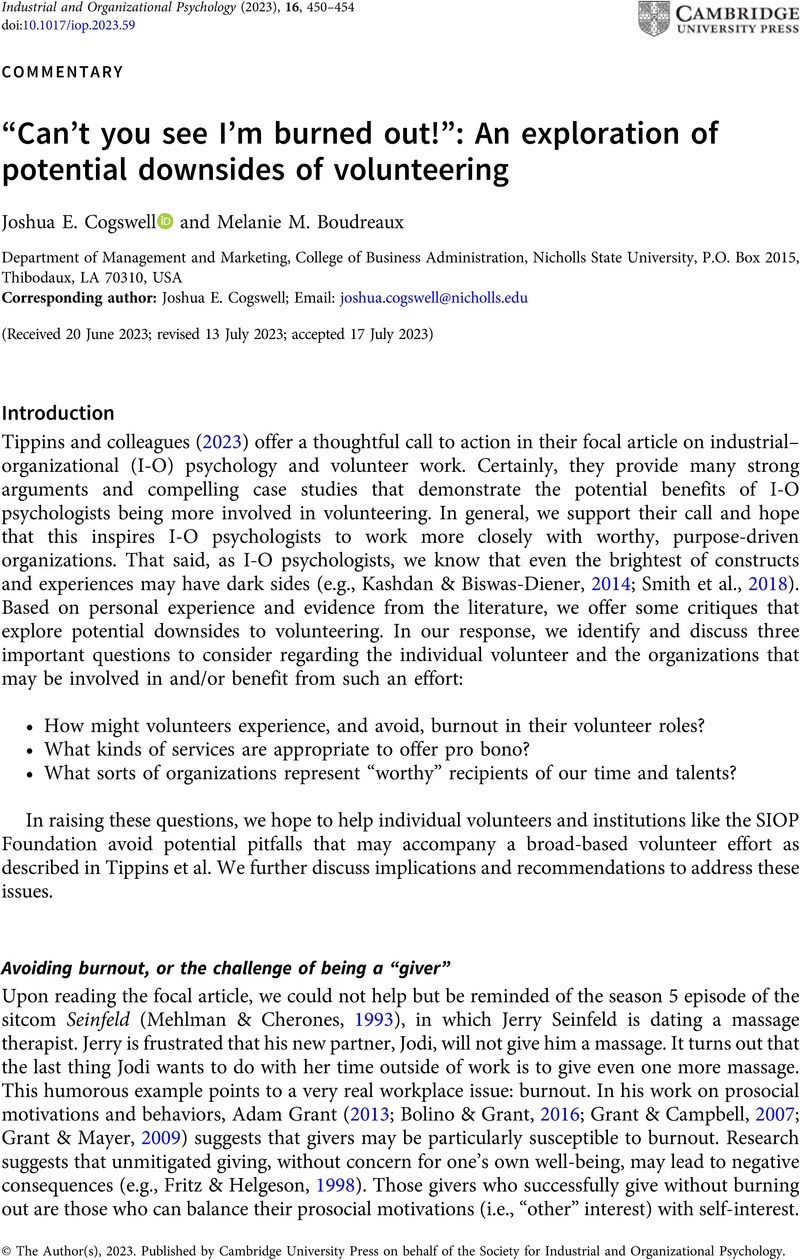No CrossRef data available.
Article contents
“Can’t you see I’m burned out!”: An exploration of potential downsides of volunteering
Published online by Cambridge University Press: 22 November 2023
Abstract
An abstract is not available for this content so a preview has been provided. Please use the Get access link above for information on how to access this content.

- Type
- Commentaries
- Information
- Copyright
- © The Author(s), 2023. Published by Cambridge University Press on behalf of the Society for Industrial and Organizational Psychology
References
Bolino, M. C., & Grant, A. M. (2016). The bright side of being prosocial at work, and the dark side, too: A review and agenda for research on other-oriented motives, behavior, and impact in organizations. Academy of Management Annals, 10(1), 599–670.CrossRefGoogle Scholar
Chen, C. F., & Yu, T. (2014). Effects of positive vs negative forces on the burnout-commitment-turnover relationship. Journal of Service Management, 25(3), 388–410.CrossRefGoogle Scholar
Fernet, C., Austin, S., Trépanier, S. G., & Dussault, M. (2013). How do job characteristics contribute to burnout? Exploring the distinct mediating roles of perceived autonomy, competence, and relatedness. European Journal of Work and Organizational Psychology, 22(2), 123–137.CrossRefGoogle Scholar
Fritz, H. L., & Helgeson, V. S. (1998). Distinctions of unmitigated communion from communion: self-neglect and overinvolvement with others. Journal of Personality and Social Psychology, 75(1), 121.CrossRefGoogle ScholarPubMed
Grant, A. (2013). In the company of givers and takers. Harvard Business Review, 91(4), 90–97.Google ScholarPubMed
Grant, A. M., & Campbell, E. M. (2007). Doing good, doing harm, being well and burning out: The interactions of perceived prosocial and antisocial impact in service work. Journal of Occupational and Organizational Psychology, 80(4), 665–691.CrossRefGoogle Scholar
Grant, A. M., & Mayer, D. M. (2009). Good soldiers and good actors: prosocial and impression management motives as interactive predictors of affiliative citizenship behaviors. Journal of Applied Psychology, 94(4), 900.CrossRefGoogle ScholarPubMed
Greenhaus, J. H., & Powell, G. N. (2006). When work and family are allies: A theory of work-family enrichment. Academy of Management Review, 31(1), 72–92.CrossRefGoogle Scholar
Grzywacz, J. G., & Marks, N. F. (2000). Family, work, work-family spillover, and problem drinking during midlife. Journal of Marriage and Family, 62(2), 336–348.CrossRefGoogle Scholar
Kashdan, T. B., & Biswas-Diener, R. (2014). The upside of your dark side: Why being your whole self—not just your" good" self—drives success and fulfillment. Penguin.Google Scholar
Mehlman, P.(writer), & Cherones, T.(director) (1993, November 18). The Masseuse (Season 5, Episode 9). [TV series episode]. In Seinfeld. Columbia Pictures Television.Google Scholar
Moreno-Jiménez, M. P., & Villodres, M. C. H. (2010, Prediction of burnout in volunteers. Journal of Applied Social, 40(7), 1798–1818.Google Scholar
Smith, M. B., Hill, A. D., Wallace, J. C., Recendes, T., & Judge, T. A. (2018). Upsides to dark and downsides to bright personality: A multidomain review and future research agenda. Journal of, 44(1), 191–217.Google Scholar
Tippins, N., Hakel, M., Grabow, K., Kolmstetter, J., Moses, D. O., & Scontrino, P. (2023). I-O psychologists and volunteer work. Industrial and Organizational Psychology, 16(4), 421–432.CrossRefGoogle Scholar


